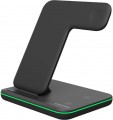Power (with 1 device)
The maximum power that the charger is capable of delivering to one rechargeable gadget (for models with 1 connector or with 1 wireless platform — the actual charging power). We emphasize that for wireless devices, it is the power in the wireless format that is indicated here (even if the design has a USB port with a higher power). Wired chargers usually list the USB power with the highest charging current or with support of the most powerful fast charging technology.
The smallest value of this metric nowadays is actually
5 W. Other popular options include
10W,
12W,
15W, and the most powerful models have
18W or more
to charge laptops(up to
100W).
Higher output power allows you to speed up the charging process; and in the case of wireless devices, a value of more than 10 watts already allows us to talk about the presence of fast charging. At the same time, a number of nuances are associated with this parameter. Firstly, not only the charger, but also the gadget being charged should support the appropriate power — otherwise the speed of the process will be limited by the specs of the gadget. Secondly, in order to use the full capabilities of the charger, it may be necessary to support not only the appropriate charging power, but also a
...certain fast charging technology (see "Fast charging"). Thirdly, in a charger with several charging connectors, the maximum power per device can only be achieved if the other ports are not used.Power (for all ports)
The total power provided by the device while simultaneously charging the maximum possible number of gadgets. This parameter is indicated only for models that can work with several gadgets; for a 1-socket charger or a wireless platform, the operating power is given in the “Power per 1 device” paragraph.
When evaluating this parameter, two points should be taken into account. First, when the charger is fully loaded, the power of each individual port and/or wireless platform may be lower than the maximum possible value. For example, some models with 2 USB ports for 2 A and 1 A (10 W and 5 W), with simultaneous operation of both ports, can output only 5 W each, that is, only 10 W in total (this is the number and indicated in this paragraph). Secondly, the distribution of power over individual connectors can be different — depending on the current on each port and supported fast charging technologies; these nuances are best specified in the official documentation.
Cable length
The length of the cable supplied with or included with the charger. For wireless models, the length of the power cable of the charger itself is indicated here, for wired models, the length of the cord for charging gadgets
Anyway, a longer cable gives more freedom of movement, but it creates inconvenience for short distances. Also note that charging is supposed to be used in the immediate vicinity of sockets, so wires longer than 2 m are practically not found among such devices. A length of
more than 1.5 m is considered significant, from 1 to 1.5 m — medium, from 0.5 to 1 m — small, and in some models there are wires shorter than 0.5 m.
Power adapter
Whether or not
a power adapter is included with the charger.
This feature is relevant primarily for wireless models, including the ones for cars(see "Type"). Such devices usually consist of three parts: the charger itself with a platform/stand/latch, a charger power cable and an adapter for connecting the wire to a power outlet or cigarette lighter. If the presence of an adapter is initially indicated in the specifications, then the charger is supplied in a complete set; it is these models that you should pay attention to if you want to use the device right out of the box, without the hassle of finding additional accessories.
Also, this feature can be indicated for individual car chargers of the traditional, wired type. This usually means that the device is similar in layout to wireless models: main unit, power cord and cigarette lighter adapter. This design allows you to use the charger at some distance from the dashboard of the car — for example, take it to the back seat, giving passengers the opportunity to charge their phones. In this case, the adapter can have its own charging outputs (usually USB) and can be used separately from the main unit.

